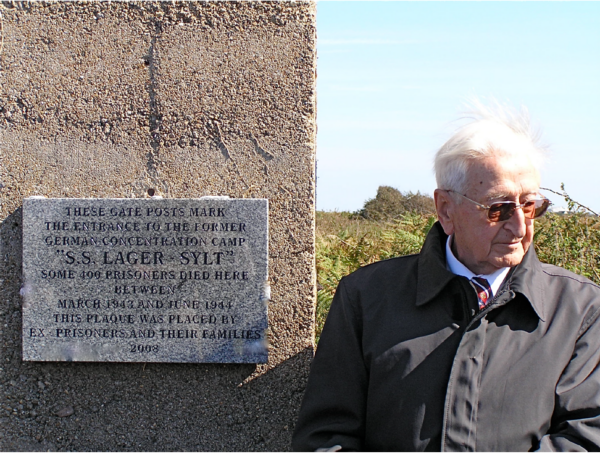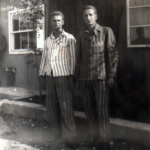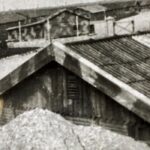Sylwester Kukula
- Date of Birth: December 17, 1923
- Place of Birth: Gorzyce Wielkie near Ostrow Wielkopolski, Western Poland
- Date of Deportation: Arrived Alderney 5 March 1943
- Address when Deported: Gorzyce Wielkie near Ostrow Wielkopolski, Western Poland
- Place of deportation: Alderney
- Sites deported to: Sylt SS camp,
By Yolanta Boot
Sylwester Kukula was born on 17 December 1922 and lived in a small village,Gorzyce Wielkie near Ostrow Wielkopolski, in western Poland. When Germany occupied that area in 1939 all schools and other public places like theatres, cinemas and churches were ordered to close. In the autumn the school pupils organised secret education, thinking that the war would not last very long. By the spring they stopped teaching having been put off by mass arrests, forced removals from homes, shootings, house searches and other acts of repression. Yet that did not save him from being picked up from his work place on 10 May 1940 and interrogated many times, moved from one prison to another and two weeks later sent to Dachau concentration camp. After a year there, filled with muster and
physical drills, he was given work as a garden labourer. At one time, as punishment for some minor trespass, he was taken to the sick bay and given a malaria infection in an ‘experiment’ to find an antidote.
In September 1942, with a group of other young prisoners, he was transported to a camp in Sachsenhausen. There, the following month, he and his friend Rysiek were incorporated into a newly created special construction brigade of some 1000 men, called SS-Baubrigade, equipped with new winter clothes (striped of course), shoes, hats and even gloves and sent off to Düsseldorf. Here the Baubrigade was divided into two groups: his stayed in Düsseldorf, the other went off to Duisburg. He initially worked at removing rubble but damaged his hand so was directed to light duties. But there an angry SS man punched him in the mouth and knocked most of his teeth out.
In February 1943 the other group came back and in March they were all transported to Alderney to Camp Sylt. Until the autumn he worked in a laundry just outside St. Anne. Obviously he was very lucky, as the working conditions there were much easier than those in the quarries or digging out ditches, and his chances of survival were greatly improved.
After the evacuation from Alderney to St. Malo in June 1944 the prisoners were taken by train, very slowly and with frequent stops, across France to arrive in Belgium in August 1944. There had been now some escapes, a few even successful. My father did not manage to escape and worked in various places. At some stage, in September, he was ordered to burn the camp documents as the front was approaching and in the process came across a few photographs, including some from Alderney, which he managed to save and keep. Later on, transported again through Holland, Germany and Bohemia, with working stopovers on the way, their transport reached Steyr in Austria on 28 April 1945. Until that time their Lagerführer was Högelow, who, now wounded, went to hospital. On 3 May Obersturmführer Braun addressed them in gentle tones and talked of the end of the war. Two days
later the camp gates opened wide and they were told in English that they were free.
The following day he met his future wife, who with her mother and sisters had just been liberated from a labour camp nearby, but they went back home a few days later. He was eventually, in September, released to return to Poland, having been forced to work for the Russians until then. After the war when they both finally found each other again, got married and settled in Warsaw, his main employment was in the new governmental organisations (agriculture and horticulture).
He visited Alderney in 2001 and unveiled the commemorative plaque in September 2008. Here is the speech his daughter read in English at the unveiling of the plaque on 21 September 2008:
“How strange are the wheels of fortune. As a young Polish boy, before the war, at school, I had lessons about Great Britain, but I never heard of an island called Alderney. Yet I found myself on it in 1943. How did it happen? Having been arrested as a ‘student’ – for teaching Polish – together with a group of 1475 other ‘students’ in 1940 I was sent to Dachau near Munich. Then in 1942 to Sachsenhausen where the new work units were created, so called construction brigades whose original purpose was to clear rubble from bombed sites in Düsseldorf and Duisburg. Most newcomers to Sachsenhasuen were put into those brigades, as the old prisoners already had regular assignments. They moved our Baubrigade to Alderney and on 5 March 1943 I stood in front of this place as I am doing now. The sign SS Lager Sylt was above these gates. What happened behind them for the following 15 and half months has still been only partially described. Suffice to say that out of 1000 men entering these gates only about 600, still barely alive, left them. I was lucky, I survived, even the whole way back to Austria and on to the liberation day. On 9 May 1945 we were about 350. Another turn of the wheel. Back in 2001 my daughter brought me here to revisit the places with haunting memories. Never did I expect to do that again. Yet today, after 65 years, I am deeply moved to stand again in front of what now are just the gateposts. On one of them we, ex-prisoners (there is another known survivor, in Belgium, unable to come over) and members of our families, are placing this plaque to commemorate them and those who died here. All nationalities were here: Russians, Ukrainians, Belorussians, Poles, Germans, Dutch, Czechs and Slovaks, French, Yugoslavs, Lithuanians. Let this marked gatepost stand here forever to remind and warn. Let similar camps never be again anywhere. I bow and salute all Sylt prisoners.”
Further Information
Map
- Cemetery / Mass Grave
- Concentration Camp
- Forced Labour Camp
- Prison
- Worksite / Fortification


